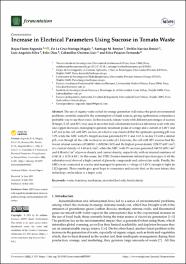| dc.contributor.author | Rojas-Flores, Segundo | es_ES |
| dc.contributor.author | De La Cruz-Noriega, Magaly | es_ES |
| dc.contributor.author | Benites, Santiago M. | es_ES |
| dc.contributor.author | Delfín-Narciso, Daniel | es_ES |
| dc.contributor.author | Angelats-Silva, Luis | es_ES |
| dc.contributor.author | Felix, Díaz | es_ES |
| dc.contributor.author | Cabanillas-Chirinos, Luis | es_ES |
| dc.date.accessioned | 2022-11-23T16:11:32Z | |
| dc.date.available | 2022-11-23T16:11:32Z | |
| dc.date.issued | 2022-07-16 | |
| dc.identifier.uri | https://hdl.handle.net/20.500.13053/7216 | |
| dc.description.abstract | “The use of organic waste as fuel for energy generation will reduce the great environmental
problems currently caused by the consumption of fossil sources, giving agribusiness companies a
profitable way to use their waste. In this research, tomato waste with different percentages of sucrose
(0-target, 5, 10, and 20%) was used in microbial fuel cells manufactured on a laboratory scale with zinc
and copper electrodes, managing to generate maximum peaks of voltage and a current of 1.08 V and
6.67 mA in the cell with 20% sucrose, in which it was observed that the optimum operating pH was
5.29, while the MFC with 0% (target) sucrose generated 0.91 V and 3.12 A on day 13 with a similar
pH, even though all the cells worked in an acidic pH. Likewise, the cell with 20% sucrose had the
lowest internal resistance (0.148541 ± 0.012361 KΩ) and the highest power density (224.77 mW/cm2
)
at a current density of 4.43 mA/cm2
, while the MFC with 0% sucrose generated 160.52 mW/cm2
and 4.38 mA/cm2 of power density and current density, respectively, with an internal resistance of
0.34116 ± 0.2914 KΩ. In this sense, the FTIR (Fourier-transform infrared spectroscopy) of all the
substrates used showed a high content of phenolic compounds and carboxylate acids. Finally, the
MFCs were connected in a series and managed to generate a voltage of 3.43 V, enough to light an
LED (green). These results give great hope to companies and society that, in the near future, this
technology can be taken to a larger scale.“ | es_ES |
| dc.format | application/pdf | es_ES |
| dc.language.iso | eng | es_ES |
| dc.publisher | MDPI | es_ES |
| dc.rights | info:eu-repo/semantics/openAccess | es_ES |
| dc.rights.uri | https://creativecommons.org/licenses/by/4.0/ | es_ES |
| dc.subject | "waste; tomatoes; saccharose; microbial fuel cells; bioelectricity " | es_ES |
| dc.title | Increase in Electrical Parameters Using Sucrose in Tomato Waste | es_ES |
| dc.type | info:eu-repo/semantics/article | es_ES |
| dc.identifier.doi | https://doi.org/10.3390/fermentation8070335 | es_ES |
| dc.type.version | info:eu-repo/semantics/publishedVersion | es_ES |
| dc.publisher.country | CH | es_ES |
| dc.subject.ocde | http://purl.org/pe-repo/ocde/ford#3.03.00 | es_ES |


